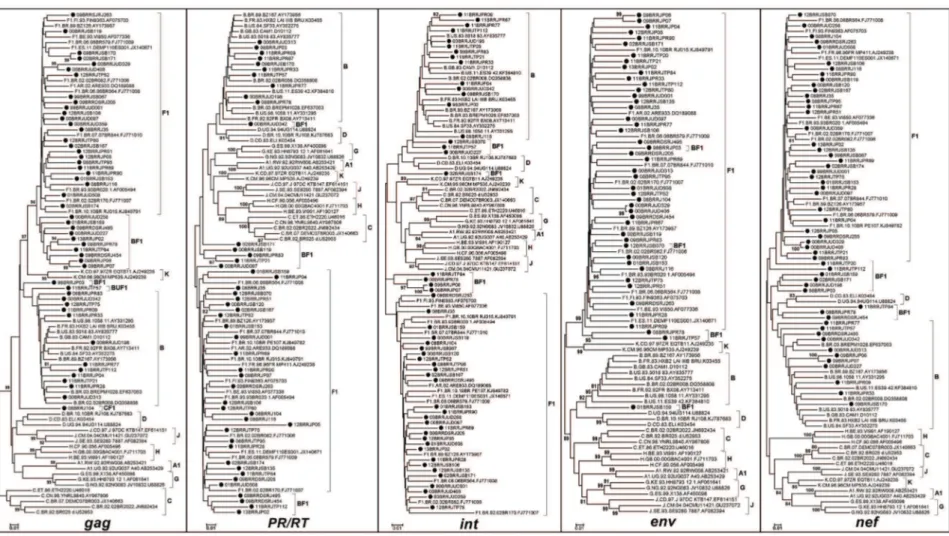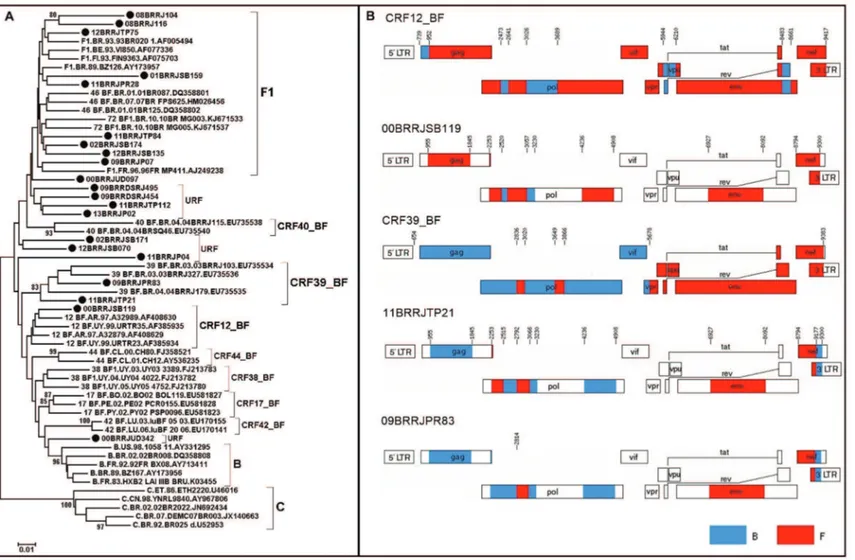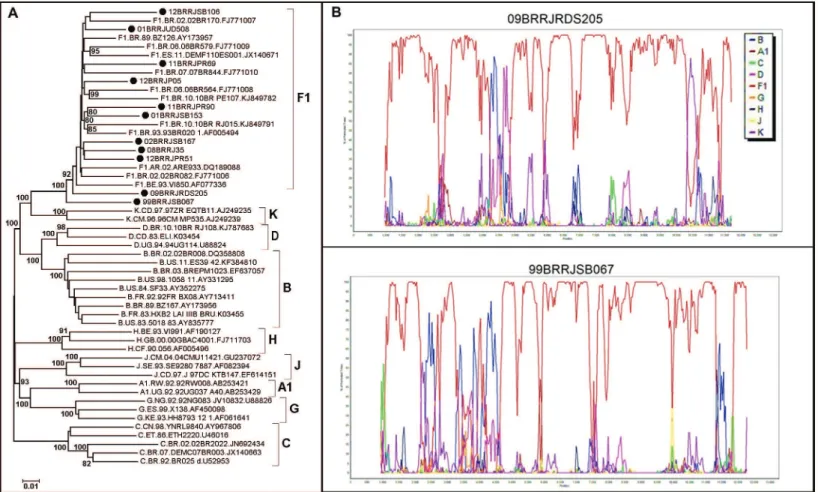Mem Inst Oswaldo Cruz, Rio de Janeiro, Vol. 113(8): e170483, 2018 1|6
online | memorias.ioc.fiocruz.br
SHORT COMMUNICATION
Potential overestimation of HIV-1 sub-subtype
F1 circulation in Rio de Janeiro, Brazil
Bianca Cristina Leires Marques, Mariza Gonçalves Morgado, Monick Lindenmeyer Guimarães/+
Fundação Oswaldo Cruz-Fiocruz, Instituto Oswaldo Cruz, Laboratório de Aids e Imunologia Molecular, Rio de Janeiro, RJ, Brasil
In Brazil, detection of the HIV-1 sub-subtype F1 has decreased with a simultaneous increase in detection of the recom-binant FB and FC forms. In previous HIV-1 env molecular epidemiology studies in Rio de Janeiro, 11.4% of the detected sequences were of the F1 sub-subtype. With the goal of re-estimating the prevalence of the HIV-1 F1 sub-subtype, we per-formed extended analyses of these samples by examining five genomic regions, resulting in 3.3% being confirmed as F1. Moreover, genomic analysis of 11 of the 21 samples identified as F1 confirmed that nine were F1 and two were BF1. Con-sidering the number of samples assayed, the prevalence of F1 was quite low, which supports the use of different genomic regions for the assessment of HIV-1 classification in countries where several subtypes and recombinant forms co-circulate.
Key words: HIV-1 - sub-subtype F1 - full-length genome - molecular epidemiology – genotyping
doi: 10.1590/0074-02760170483
Financial support: CNPq (grant number: 307972/2014-3). MLG and MGM are recipients of fellowships from CNPq. + Corresponding author: monicklg@ioc.fiocruz.br Received 7 November 2017
Accepted 25 April 2018
The HIV-1 group M is responsible for approximate-ly 90% of HIV infections worldwide (Hemelaar et al. 2011). Based on its genetic variation, this group can be divided into nine subtypes (A-D, F-H, J, and K) that exhibit 17-35% and 8-17% of intra- and inter-subtype variation, respectively, depending on the genomic region analysed. The HIV-1 subtype F was initially described by Dumitrescu in 1994 (Dumitrescu et al. 1994) using samples from Romanian HIV-1 infected individuals and simultaneously from Brazilian individuals (Morgado et al. 1994). Posterior analysis of the African sequences al-lowed for the reclassification of this subtype into sub-subtypes F1 and F2. The F1 sub-subtype has been identi-fied in European (Romania, Italy, Spain and Russia) and South American countries (Argentina, Chile, Bolivia and Brazil), while F2 is mostly restricted to Central Af-rican countries (Hemelaar et al. 2011).
Based on compiled data from 2000 to 2007, the prevalence of HIV-1 sub-subtype F1 was estimated as 0.45% worldwide (Hemelaar et al. 2011). Among the 6948 complete HIV-1 genomic sequences present in the Los Alamos HIV database (http://www.hiv.lanl.gov/, ac-cessed in August, 2017), only 58 (0.8%) belong to the F1 sub-subtype, 15 (0.2%) of which are from Brazil. In ad-dition, this sub-subtype is reported in 15 of the 90 (17%) HIV-1 circulating recombinant forms (CRFs) already described, frequently in association with the B subtype. Of these 15 CRF_BF1, nine were described in Brazilian individuals, and only one was reported outside of South America (http://www.hiv.lanl.gov/content/sequence/ HIV/CRFs/CRFs.html, accessed in August, 2017).
Previous molecular epidemiological studies from Rio de Janeiro attempted to describe the prevalence of HIV-1 sub-subtype FHIV-1 and BFHIV-1 recombinants based on only small genomic segments, typically from the env (C2V3) or pol (PR/RT) genes. Regarding the C2V3 segment, es-timates of the prevalence of sub-subtype F1 ranged from 9.3% to 24.4%, while the prevalence of BF1 recombinants was estimated to be approximately 1%. For the PR/RT re-gion, the prevalence of sub-subtype F1 varied from 4.9 to 22.2%, while that of the BF1 recombinants ranged from 3.3% to 14.8%. Although the first description of the HIV-1 BF1 recombinant strain was based on the analysis of the
env gp120 V1-V5 fragment (Sabino et al. 1994), further de-scriptions were typically based only on the viral pol gene. Studies based on the env gene detected a higher prevalence of sub-subtype F1 than of the BF1 recombinants, and the opposite could be verified in studies based on the PR/RT region. Thus, to obtain a more accurate estimate of the frequency of sub-subtype F1 in the Rio de Janeiro HIV-1 epidemic, we characterised five genomic regions of se-quences obtained from HIV-1 F1 samples, which were pre-viously identified based only on sequence analysis of the C2V3 region of gp120. In addition, the complete genomes from some of the samples were sequenced.
Bianca Cristina Leires Marques et al. 2|6
The extracted DNA was assayed by nestedpolymerase chain reaction (PCR) and sequenced, covering five re-gions of the HIV-1 genome: gag (nt 836-1844 relative po-sition to HXB2), pr/rt (nt 2253- 3555 relative position to HXB2), int (nt 4173- 5213 relative position to HXB2), env
(nt gp41/gp120- 6817-8277 relative position to HXB2) and
nef (nt 8698-9474 relative position to HXB2). The chro-matograms were edited and assembled using SeqMan from the DNASTAR package. The sequences obtained for each genomic region were assayed using Clustal W in MEGA 6.0, and the phylogenetic analyses were per-formed using the neighbor-joining (NJ) method and the Tamura-Nei substitution model. Reference sequences for the HIV-1 group M subtypes (A-D, F, H, J and K) were obtained from the Los Alamos HIV database (http://hiv. lanl.gov/). Bootstrapping (1000 re-samples) was used to evaluate the reliability of the phylogenetic tree topology. All samples were assessed by recombination analysis us-ing the bootscannus-ing method as implemented in Simplot 3.5.1, with the following parameters: 200-nt window, 20-nt increme20-nts, NJ method with Kimura’s two-parameter correction, and 100 bootstrap replicates.
A subset of samples classified as sub-subtype F1 for all HIV-1 genomic regions analysed were further as-sayed by full-length amplification using four overlap-ping fragments amplified by nested PCR, as previously described in Reis et al. (2017).
Genomic sequences were determined using 1 ng of an equimolar mixture of the four amplified fragments. They were subsequently sequenced using the Illumina HiSeq2500 platform following the manufacturer’s proto-col (Illumina®, San Diego, California, USA). The raw data were processed using Trimmomatic to exclude adaptors. Only bases with Q>30 in Sickle were considered for assem-bling the genomes. After genome assembly, the consensus genomic sequences obtained were subjected to phylogenet-ic and recombination analyses, as described above.
From the fifty-five HIV-1 sub-subtype F1 samples analysed in this study, all five genomic fragments (gag,
pol (PR/RT), int, env (gp120/gp41) and nef) were am-plified from thirty-four samples (71%), while four (n = 15) or three fragments (n = 6) were amplified from the remaining samples.
Phylogenetic trees were reconstructed for each of the five genomic regions (Fig. 1), and each fragment was subtyped based on phylogenetic and recombination analyses. Although some (< 80) were detected in clade branches, removal of the recombinant samples allowed for an increase in these values to > 80 as follows: GAG (F1 from 38 to 97 and B from 58 to 99), PR/RT (F1 from 12 to 82 and B from 42 to 83), INT (F1 from 79 to 90 and B from 28 to 81), ENV (F1 from 55 to 99 and B 95 to 98) and NEF (F1 from 37 to 99 and B from 8 to 80). Recombinant sequences were detected in gag (36%),
nef (33%), pol (PR/RT) (28%) and int (22%). The final subtype classification of each sample was a result of the analysis of the crossing data of all studied genomic regions. Twenty-one out of 55 samples could be classi-fied as “pure” HIV-1 sub-subtype F1, and 34 could be
assigned as a CRF_BF1, as already described, we per-formed a phylogenetic analysis of the PR/RT fragment. This analysis included all CRF_BF1 classified as F1 in the C2V3 region, since this was the selection criterium for the samples to be included in this work (Fig. 2). Al-though three sequences clustered together with a given CRF (1 CRF12_BF, 2 CRF39_BF), they did not have the same breakpoints along the genomic fragments analysed (Fig. 2), indicating that they were unique recombinant forms (URF). Of the 55 samples assayed, 20 were col-lected from 1998 to 2002, nine (45%) of which were characterized as HIV-1 sub-subtype F1 and 11 (55%) of which were characterised as BF1 recombinants. The re-maining 35 samples were collected between 2008 and 2013, of which 12 (34.2%) were classified as the HIV-1 F1 sub-subtype, 21 (60%) as BF1, one (2.9%) as CF1 and one (2.9%) as BF1U. The decrease in HIV-1 sub-subtype F1 and the increase in recombinant forms between these two time intervals were not significant.
After characterising these samples for least three HIV-1 genomic regions and with the goal of making a more ac-curate estimate of the presence of HIV-1 sub-subtype F1 in our samples, we used the following rationale. Original-ly, 635 samples were characterized based on the C2V3 env
region, of which 74 (11.6%) were classified as the F1 sub-subtype but only 55 (75%) had biological material avail-able for further testing. The reanalysis of these 55 samples using at least three genomic regions revealed that only 21 samples (38%) were confirmed to be F1. These results
led to an overall estimation of 3.3% (21/635) to 4.3% (≈
28/635) for this sub-subtype, which was calculated based on 38% of the original 74 (n = 28) C2-V3 sub-subtype F1 samples and on the sub-subtype F1 prevalence observed in our sub-sampling. The HIV-1 F1 frequency estimation based on each of the studied regions was as follows: gag
(3.9%), pr/rt (4.2%), int (4.6%), and env (6.5%). Alone, none of the five regions analysed permitted an accurate estimation of the frequency of the HIV-1 sub-subtype F1.
The 21 samples characterised as containing HIV-1 F1 in at least three genomic studied regions of the ge-nome were further assayed by full gege-nome amplifica-tion, by using next generation sequencing (NGS). Of these, 11 (52.4%) were successfully amplified and se-quenced. Nine of the 21 samples were confirmed as con-taining pure HIV-1 sub-subtype F1, and two contained URF_BF1 (Fig. 3), leading to a reduction in at least 18% (2 out of 11) of our estimates.
Considering the results of the classification based on the five genomic regions and on the full-length ge-nomes, we could estimate that the frequency of HIV-1 sub-subtype F1 in our samples is approximately 3%.
Mem Inst Oswaldo Cruz
, Rio de Janeiro, V
ol.
113
(8), 2018
3|
6
B
ia
n
ca C
ris
tin
a L
eir
es M
ar
q
u
es e
t a
l.
4|
6
Mem Inst Oswaldo Cruz
, Rio de Janeiro, V
ol.
113
(8), 2018
5|
6
Bianca Cristina Leires Marques et al. 6|6
molecular epidemiological data from partial or full ge-nomic sequences from 2004 to 2007, HIV-1 recombinant sequences (URFs and CRFs) accounted for 20% of HIV-1 forms (Hemelaar et al. 20HIV-1HIV-1), and until now, 90 CRFs have been described in the Los Alamos database (http:// www.hiv.lanl.gov/content/sequence/HIV/CRFs/CRFs. html, accessed in August 2017). Taken together, this in-formation reflects the increased importance of the re-combinant forms in the HIV-1 pandemic. Thus, changes in HIV-1 diversity surveillance analysis are necessary (Hemelaar et al. 2011). However, obtaining full-length genome sequences is still expensive and laborious, even when applying NGS methods. To address this problem, in the present study, we investigated the use of five HIV-1 genomic regions to assess HIV-HIV-1 diversity, including highly recombinogenic regions [pol (PR/RT), int and
env (gp41)] (Magiorkinis et al. 2003).
Previous molecular epidemiological studies revealed distinct HIV-1 subtype prevalence according to the ana-lysed genomic region and depending on collection date and risk groups. The use of more than one gene or the full-length genome has allowed a smaller F1 prevalence (0.5 to 4.5%) to be observed (Guimarães et al. 2002, Sanabani et al. 2009, Sanabani et al. 2011). Based on our dataset from Rio de Janeiro, the frequency of HIV-1 sub-subtype F1 also varied according to the genomic region, ranging from 11.6% when using C2V3 env to 3.9% when using
gag. Thus, when using gag, we would be able to identify 36% of the recombinants, while when using pol (PR/RT), the most used region due to it being an HIV antiretroviral target, we would be able to identify 28% of the recombi-nants. The use of gag and pol together allowed for a re-combinant detection of 67%; however, the highest recom-binant detection (72%) was obtained using gag and nef.
In conclusion, subtype classification based on more than three genomic regions, combined with the results based on full-length genomes, allowed us to estimate the occurrence of sub-subtype F1 of approximately 3% in our samples from Rio de Janeiro. This indicates an over-estimation of the occurrence of this sub-subtype in pre-vious studies based only on the C2V3 region sequence.
Sequence data - All nucleotide sequences are available from the GenBank database, with accession numbers as follows: ENV (MG365686-MG365721), GAG (MG365722-MG365760), full-length genomes (MG365761-MG365771), I NT ( MG365772-MG365808), N EF( MG365809-MG365851), and POL (MG365852-MG365882).
ACKNOWLEDGEMENTS
To Edson Delatorre and Thaysse Cristina Neiva Leite for critical revision and suggestions, and Vera Bongertz for Eng-lish revision and suggestions. We also thank the Fiocruz DNA Sequencing Platform and the IOC/FIOCRUZ High Perfor-mance Sequencing Platform for performing NGS.
AUTHORS’ CONTRIBUTION
MLG, MGM and BCLM conceived and designed the ex-periments; BCLM and MLG performed the experiments and
REFERENCES
Dumitrescu O, Kalish ML, Kliks SC, Bandea CI, Levy JA. Charac-terization of human immunodeficiency virus type 1 isolates from children in Romania: identification of a new envelope subtype. J Infect Dis. 1994; 169(2): 281-8.
Guimarães ML, Couto-Fernández JC, Eyer-Silva WA, Teixeira SL, Chequer-Fernández SL, Morgado MG. Analysis of HIV-1 BF pr/rt recombinant strains from Rio de Janeiro/Brazil reveals multiple un-related mosaic structures. Infect Genet Evol. 2010; 10(7): 1094-100.
Guimarães ML, Marques BC, Bertoni N, Teixeira SL, Morgado MG, Bastos FI, et al. Assessing the HIV-1 epidemic in Brazilian drug users: a molecular epidemiology approach. PLoS One. 2015; 10(11): e0141372.
Guimarães ML, Moreira AS, Loureiro R, Galvão-Castro B, Morgado MG. Characterization BNfHIa. High frequency of recombinant genomes in HIV type 1 samples from Brazilian southeastern and southern regions. AIDS Res Hum Retroviruses. 2002; 18(17): 1261-9.
Hemelaar J, Gouws E, Ghys PD, Osmanov S. Characterisation W-UNfHIa. Global trends in molecular epidemiology of HIV-1 dur-ing 2000-2007. AIDS. 2011; 25(5): 679-89.
Leite TC, Campos DP, Coelho AB, Teixeira SL, Veloso V, Morgado MG, et al. Impact of HIV-1 subtypes on AIDS progression in a Brazilian cohort. AIDS Res Hum Retroviruses. 2017; 33(1): 41-8.
Magiorkinis G, Paraskevis D, Vandamme AM, Magiorkinis E, Sypsa V, Hatzakis A. In vivo characteristics of human immunodeficien-cy virus type 1 intersubtype recombination: determination of hot spots and correlation with sequence similarity. J Gen Virol. 2003; 84(Pt 10): 2715-22.
Morgado MG, Sabino EC, Shpaer EG, Bongertz V, Brigido L, Guima-raes MD, et al. V3 region polymorphisms in HIV-1 from Brazil: prevalence of subtype B strains divergent from North American/ European prototype and detection of subtype F. AIDS Res Hum Retroviruses. 1994; 10(5): 569-76.
Pimentel VF, Morgado MG, Bello G, Guimarães MD, Castilho EA, Veloso VG, et al. Temporal trends and molecular epidemiology of HIV type 1 infection in Rio de Janeiro, Brazil. AIDS Res Hum Retroviruses. 2013; 29(12): 1553-61.
Reis MNDG, Bello G, Guimarães ML, Stefani MMA. Character-ization of HIV-1 CRF90_BF1 and putative novel CRFs_BF1 in Central West, North and Northeast Brazilian regions. PLoS One. 2017; 12(6): e0178578.
Sabino EC, Shpaer EG, Morgado MG, Korber BT, Diaz RS, Bongertz V, et al. Identification of human immunodeficiency virus type 1 envelope genes recombinant between subtypes B and F in two epidemiologically linked individuals from Brazil. J Virol. 1994; 68(10): 6340-6.
Sanabani SS, Pastena É, da Costa AC, Martinez VP, Kleine-Neto W, de Oliveira AC, et al. Characterization of partial and near full-length genomes of HIV-1 strains sampled from recently infected individuals in São Paulo, Brazil. PLoS One. 2011; 6(10): e25869.
Sanabani SS, Pastena ER, Kleine Neto W, Barreto CC, Ferrari KT, Kalmar EM, et al. Near full-length genome analysis of low preva-lent human immunodeficiency virus type 1 subclade F1 in São Paulo, Brazil. Virol J. 2009; 6: 78.


